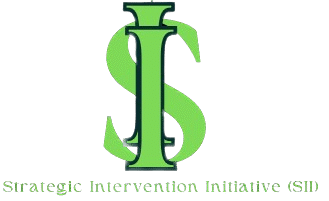Empowering Lives. Strengthening Communities.
We go beyond palliatives—providing immediate aid and building long-term solutions for the critically poor and displaced.
Who We Are
Strategic Intervention Initiative is a non-governmental organization focused on supporting critically poor or displaced persons in society. We have a distinctive approach that goes beyond short-term palliatives to create sustainable paths to empowerment.
Why we do what we do
Our experience has shown that solely providing for immediate needs can result in a vicious cycle of poverty, keeping recipients in a permanent state of need. Instead, our approach employs creative solutions to meet immediate needs while systematically empowering individuals to
become self-sufficient, contributing members of their communities . Our goal is to transform lives and strengthen communities.
Vision
Our vision is to be a leading change catalyst in our chosen communities lifting otherwise critically poor and disadvantaged persons into self sustaining positive contributors to their communities and the world at large.
Mission
Change the narrative of hopelessness and helplessness to a paradigm of personal power, responsibility and purposefulness through targeted intervention programs, processes and initiatives designed to prevent, mitigate or eliminate the underlying causes of communal and chronic poverty while also meeting the immediate needs of the affected persons.
Values
Our core values are represented in the acronym H -E-L-P-S
Honesty
Our commitment to honesty, transparency, and accountability is a fundamental principle that guides our actions and decisions, fostering trust and maintaining the highest standards of integrity.
Empowerment
Our mission is to empower the critically poor and displaced individuals by unlocking their inherent potential, providing them with necessary tools and resources to become self- sufficient and active community contributors.
Lateral Thinking
Our organization adopts a lateral thinking approach, seeking innovative solutions to address poverty and displacement by combining diverse perspectives and unconventional ideas.
Positivity
Our programs foster a positive mindset for sustainable change, encouraging individuals and communities to envision a brighter future and take action towards achieving their aspirations.
Sustainability
Our interventions prioritize sustainability, focusing on long-term impact and systemic change to ensure enduring and self- sustaining transformation within target communities.
Strategic Focus and Approach
Primary Intervention Strategies
Our intervention strategies involve immediate palliative support, paradigm shifts, practical training programs, self-sustainability packages, and close performance monitoring.
Methodology of Intervention
Our intervention approach involves providing relief aid, promoting positivity, developing skills, providing resources, and tracking progress to ensure long-term impact on target communities.
Unique Organizational Approaches
Our unique organizational approach prioritizes long-term, sustainable change through systematic empowerment strategies, focusing on individual and community circumstances, rather than short-term fixes.
Long-term Strategic Objectives
Our long-term strategic objectives are to foster positive change by empowering the poor and disadvantaged, creating a sustainable, replicable model for community development.
Intervention Areas

Detailed Population Segments
We primarily focus our efforts on internally displaced persons, residents of impoverished neighborhoods and slums, and other critically poor or marginalized groups. Within these communities, our key target demographics are women, youth, and children.
Rationale for Demographic Focus
Empowering women leads to healthier families, better education, and breaking intergenerational poverty cycles. Investing in youth provides hope and supports caregivers. Our intervention programs address unique challenges faced by each target population, such as healthcare, education, and social marginalization. We use a targeted methodology to optimize supportmechanisms.
Strategic Intervention Initiative focuses on three key areas: Healthcare, Education, and Empowerment, aiming to alleviate poverty and promote community development. These interventions provide immediate assistance while building long-term capacity, ensuring sustainable impact and lasting change.

Healthcare Interventions
- Specific Healthcare
Services - Healthcare Delivery
Mechanisms - Impact Measurements
- Future Healthcare
Strategy

Educational Interventions
- Educational Support
Mechanisms - Types of Educational
Assistance - Educational
Empowerment
Strategies - Learning Outcome
Tracking

Empowerment Initiatives
- Empowerment
Program Designs - Support Mechanism
Details - Skill Development
Approaches - Economic
Empowerment
Strategies
Operational Framework
Program Design Methodology
Our program design methodology utilizes community needs assessments and individual evaluations, segmenting beneficiaries based on circumstances and capabilities, incorporating immediate relief and self-sufficiency pathways through skill development, education, and economic empowerment.
Quality Assurance Mechanisms
Our quality assurance framework ensures consistent program delivery through regular audits, feedback systems, staff performance evaluations, stakeholder satisfaction surveys, and documentation protocols, maintaining stringent standards across all intervention areas.
Implementation Processes
The program's implementation process involves a structured five-stage approach, starting with palliative care, focusing on mental reorientation, practical training, packaged support, and performance monitoring to ensure sustainable progress.
Performance Monitoring Systems
We use robust monitoring systems to track individual progress in various metrics, enabling real- time program adjustments and strategic planning.
Continuous Improvement Protocols
Continuous improvement protocols involve systematic review processes, including quarterly evaluations, impact assessments, stakeholder feedback integration, best practice implementation, and innovation integration, to ensure interventions remain effective and relevant.
Resource Management
Funding Sources
The Strategic Intervention Initiative secures funding from various sources, including corporate partnerships, individual donors, and international development agencies. It follows a stringent financial management approach, adhering to international accounting standards. Resources are allocated based on program priorities and impact metrics, with an 80/20 ratio between direct and administrative costs. Financial transparency is maintained through quarterly reports and audits.
Human Resources
The organization uses a lean staffing model with specialized teams for healthcare, education, and empowerment programs. It operates a structured volunteer program, employs skilled professionals, community members, and international volunteers. Staff development focuses on skill enhancement, training community members, and investing in professional development through training, mentorship, and career advancement opportunities.
Material Resources
Our physical infrastructure includes program delivery centers, training facilities, and administrative offices. We utilize technology for program delivery, monitoring, and evaluation, and utilize efficient inventory management systems and cost-effective procurement practices to maximize resource utilization.
Partnerships and Collaborations
Strategic Intervention Initiative partners with healthcare providers, educational institutions, vocational training centers, and corporate organizations to provide free or subsidized care, education, job placement, mentorship programs, and fundingsupport.
Collaboration Strategies
We utilize structured collaboration frameworks, clear partnership agreements, and performance metrics to enhance program effectiveness and expand our reach into target communities.
Networking Approaches
Our networking strategy involves forming connections with government agencies, international NGOs, local community organizations, corporate entities, and academic institutions for policy alignment, knowledge sharing, grassroots engagement, and sustainable funding.
Potential Future Collaborations
Strategic partnerships in technology, financial institutions, agriculture, healthcare, and education aim to enhance intervention capacity and create sustainable impact pathways for beneficiaries.
Contact Us
- +2348185809914, +2347033746514
- info@strategicinterventioninitiative.org
- 16 Rasheed Alaba Williams Street Off Admiralty Way Lekki Phase 1 Lagos
